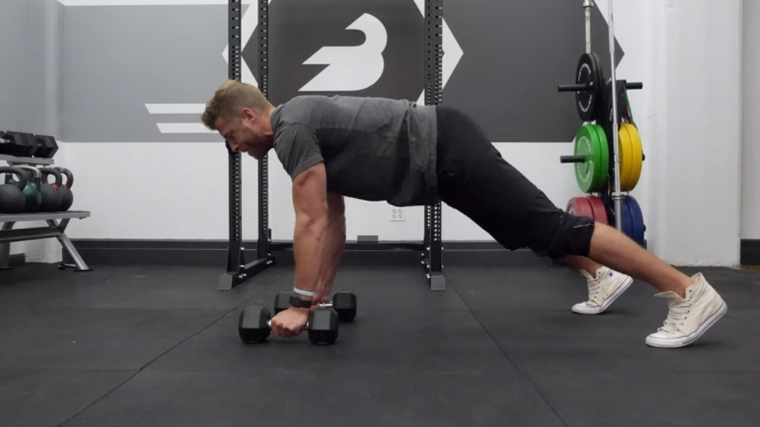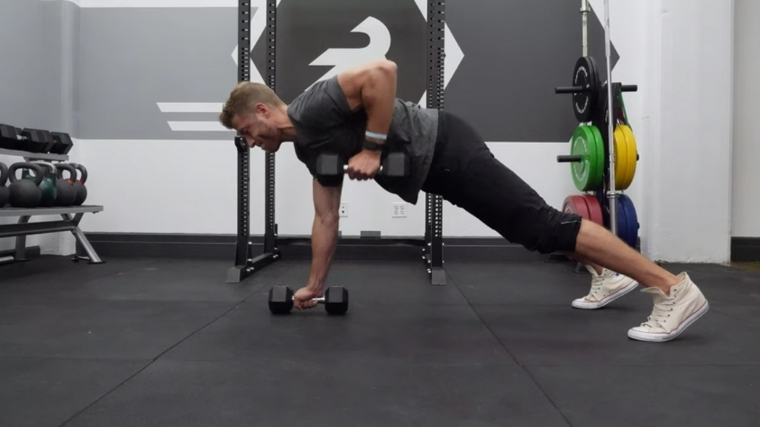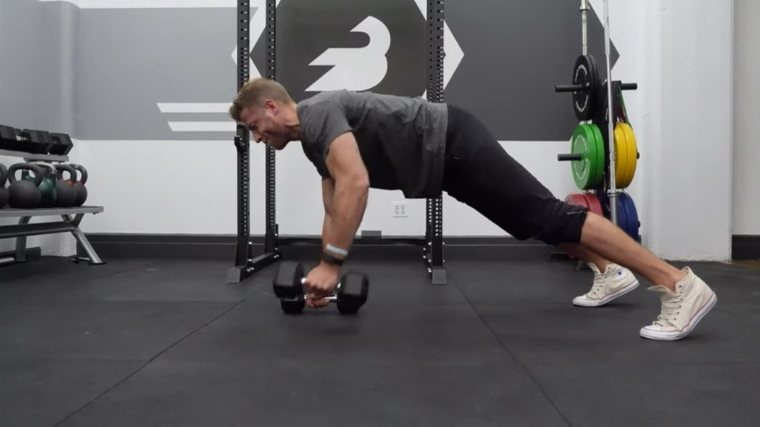There’s some truth to the expression less is more. But sometimes more is more, and when it comes to exercise selection, the renegade row is a prime example. This movement combines a plank with a dumbbell row for a hybrid exercise that trains your back and core.
It’s also very scalable, so whether you’re a beginner or a weathered gym rat, there’s more than likely a renegade row variation out there that can help you tackle whatever training adaptations you’re aiming to accomplish.
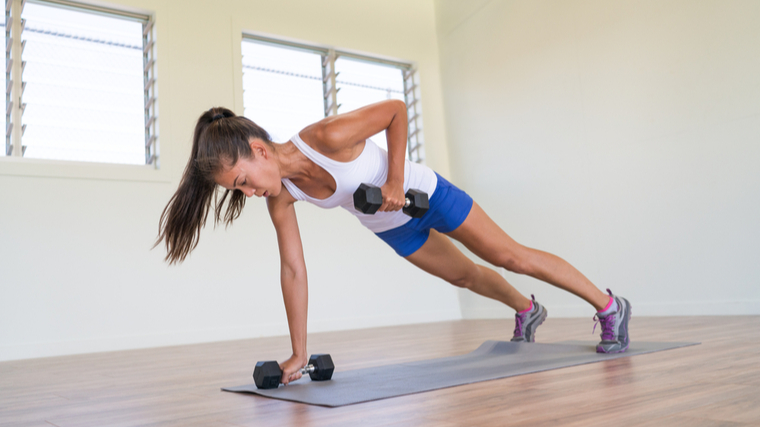
In addition to being a good muscle-building and strength-building movement, the renegade row improves midline stability and coordination when moving external loads. In this article, we’re going to dive into how to properly perform renegade rows, their benefits, mistakes, variations, and how you can use them in your program for various training adaptations.
- How to Do the Renegade Row
- Renegade Row Sets and Reps
- Common Renegade Row Mistakes
- Renegade Row Variations
- Renegade Row Alternatives
- Muscles Worked by the Renegade Row
- Benefits of the Renegade Row
- Who Should Do the Renegade Row
- Frequently Asked Questions
Renegade Row Video Guide
You can check out this video tutorial, featuring former BarBend Training Editor Jake Boly, for visual renegade row tips.
How to Do the Renegade Row
Here’s an in-depth, step-by-step breakdown of how to do the renegade row with the right form for maximum gains.
Step 1 — Set Your Base
Assume a plank position. Grip a pair of dumbbells (ideally hexagonal dumbbells that won’t roll). Set your feet wider than shoulder-width, so you’re more balanced. Brace your core, squeeze your glutes, drive your heels into the ground, and brace your entire body.
Form Tip: You can move your feet in or out to make the move harder or easier.
Step 2 — Initiate the Row
Keeping your core tight, row one of the dumbbells to your side. Lead the row with your elbow. Keep rowing until your elbow passes your torso. Be sure to maintain a neutral spine. Keep your glutes engaged.
Form Tip: Try not to let your torso twist too far away from the side you’re rowing the dumbbell. If it does, use a lighter weight.
Step 3 — Control the Eccentric
At the top of the row, control the weight back to the ground, maintaining your strong braced posture. If you’re swinging the dumbbell or hiking up your hips, then scale back the weight.
Form Tip: Keep tension on the weight as you lower it. Be sure not to let your body fall to the same side.
Renegade Row Sets and Reps
Renegage rows are going to help get you stronger: period. But this isn’t really the move you’re going to load up extra heavy. Don’t worry, you’ll be hitting it plenty hard. But since you want to be emphasizing keeping your torso and hips stable throughout the move, focus less on loading up the weight and more on your form.
- For Stability: Perform two to three sets of six reps per side, moving as slowly as you can.
- For Muscle: Do three to four sets eight to 10 reps per side, maintaining squared hips and shoulders.
- For Endurance: Do three sets of as many reps as possible on your weaker side. Rest for 90 seconds, then match that number on your dominant side.
All of these rep schemes will help you get stronger. But taking the focus away from building strength helps remind you to focus more on using a sustainable load with excellent form.
Common Renegade Row Mistakes
Renegade rows seem simple on the surface. You know how to hold a plank and you know how to do rows. How complicated can it be to combine them? Just because a move is simple in theory doesn’t mean it’s easy in practice. Check out these common lifting errors to prevent renegade row disasters.
Lifting Too Heavy
One of the most common problems with pretty much any lift is loading up the weight so heavy that you compromise your form, safety, and the effectiveness of the exercise. If you’re trying to pull too much weight with this lift, you’ll likely hike your shoulder and hip up and back to accomplish the range of motion you need.
While cheating your form is sometimes an effective way to get the most out of an exercise, renegade rows benefit from strict form. Make sure you’re lifting a weight you can pull with discipline and control while keeping squared hips and shoulders.
Landing Too Hard
Often a symptom of going too heavy, you want to avoid landing too hard with this move. To maintain your wrist health, you’ve got to keep your wrists in neutral. Lowering the dumbbell too quickly and without enough discipline can cause you to land on a corner of the dumbbell.
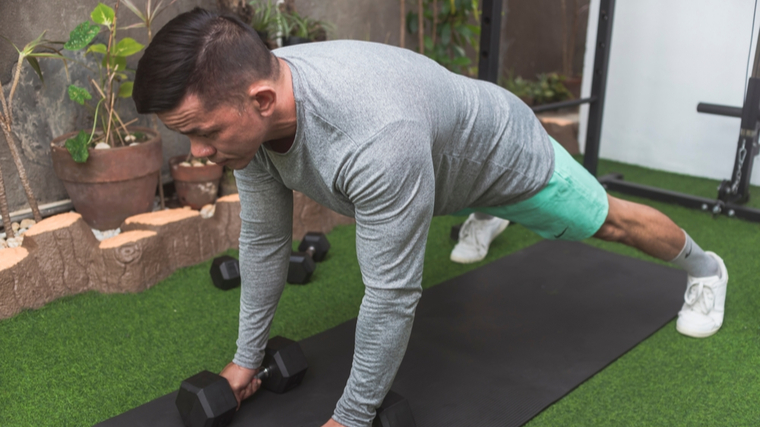
This can jostle your wrists, making it hard to keep them neutral and even risk straining them. Even if you land properly on the flat of the bell, moving without discipline can be jarring on your wrists.
Twisting Your Body
Especially if you’re using a very heavy weight, your body will likely try to heft the weight into the top position by shifting off to the side. If you’re raising the dumbbell with your right hand, your right hip and shoulder might throw themselves up and to the left to compensate for the effort.
Try your best to minimize any side-to-side movement. Focus instead of grounding through your planted hand and feet and pulling the weight up with your lats. Think about keeping your core as still as possible, like you’ve got a water bottle balanced on your lower back that you don’t want to spill.
Renegade Row Variations
The renegade row is fairly simple to scale and modify. If you’re ready to try out different versions of this move, here are three variations you can perform with the traditional renegade row.
Renegade Row Push-Up
For this variation, you’ll perform your traditional renegade rows, then hit a push-up before completing a full rep.
That means that each rep will consist of two rows and a push-up. This is a good variation if you are looking to increase upper body pressing strength and reinforce good pressing and pulling mechanics.
Kettlebell Renegade Row
The kettlebell renegade row is a great variation for lifters who want to improve how stable they are throughout the row. This variation can help anyone trying to really push their shoulder stability when performing the inverted row.
Note: This variation should be reserved for advanced athletes, as kettlebells provide a more unstable base than dumbbells. Use these implements mindfully.
Feet-Elevated Renegade Row
The feet-elevated renegade row is an incredibly tough variation. Your feet won’t be grounded, so you’ll have to work even harder to keep your grip steady and your body in position.
Since you’re limiting two points of contact, your core and hips need to work extremely hard to maintain their braced posture.
Renegade Row Alternatives
The renegade row isn’t your only option for increasing unilateral strength. There are alternatives that can also help you develop unilateral muscle growth and add variety to your training program.
Dumbbell Single-Arm Row
The dumbbell single-arm row is a unilateral row variation aimed at increasing back strength. Unlike the renegade row, the lifter can find great stability in the setup position, which allows for increased loading and back emphasis. That’s because core strength and balance can be a limiting factor in the renegade row).
This can be used as a regression for the renegade row or the main back developer if people lack the ability to gain size and strength with renegade rows. If the goal is back hypertrophy, this is one of the best dumbbell back-builders out there.
Dumbbell Bird Dog Row
The dumbbell bird dog row is a row that targets your core and back, similar to the renegade row.
However, it offers slightly more stability and can be used to set you up in a position that reinforces your spinal alignment. This move allows for fewer movement faults, as it is harder to row the weight incorrectly.
Dumbell Plank Row
The dumbbell plank row emphasizes the row action while still developing core strength or as a scaled modification for individuals who struggle to perform the renegade row.
To do this, you would assume a plank position on a weight bench and hold a dumbbell in one hand. Make sure to maintain core stability and not rotate your pelvis while you row the weight.
Muscles Worked by the Renegade Row
You’ll be performing a plank throughout the rowing movement. This means that the renegade row will keep most of your body in an isometric hold throughout your reps. But the prime movers involved in the renegade row are very similar to what is used during the dumbbell row.
Lats and Rhomboids
Like any row variation, your back and rhomboids will work to pull the load into the body and stabilize the scapular region while doing so. However, if you are after maximal back growth, you may want to opt for a row variation less dependent on core strength and balance to allow for more loading and volume.
Rectus Abdominals and Obliques
Your abdominals and obliques are used in the renegade row as stabilizers and anti-rotational muscles. While performing the row, you may try to rotate your body to lift the load. Your core is responsible for resisting this rotation, which develops a lot of core strength and stability.
Benefits of the Renegade Row
Not sold on the renegade row just yet? Here are three main benefits that you can gain from adding this exercise to your training toolbox.
Improve Midline Stability
Midline stability refers to your ability to stay tight and neutral during any exercise. Really, it’s a fancy synonym for the ability to brace. More midline stability means you can reduce your injury risk during moves like deadlifts and back squats. You’ll also build more ab strength.
The renegade row challenges — and therefore improves — midline stability as your body will fight to stay stable throughout the entire exercise. To hold the plank alone requires a lot of core strength. Then to row a dumbbell without falling over requires that all of your muscles (your quads, glutes, lower back, core, and arms) are braced.
Increase Upper Back and Lat Hypertrophy
As the name implies, there’s a rowing component to the renegade row. So, your back will get bigger and stronger. That said, you won’t be able to row as much weight compared to with a barbell or with single-arm rows, so if hypertrophy is your goal, go for more reps to increase your muscle’s total time under tension.
It’s Very Accessible
The renegade row is a move for every gymgoer. You don’t need much equipment to do it — making it a great home gym movement — and it can be made easier or harder almost instantly with minimal adjustments. Want to take it up a notch? Narrow your feet or add a push-up after each row. Want to make it easier? Widen your stance or elevate your hands even more.
Who Should Do the Renegade Row
Athletes at many different levels of experience and with various goals can definitely incorporate this rowing variation into their program.
Strength and Power Athletes
The renegade row has little direct application to the competition lifts. However, it can increase core strength, scapular stability and be used as a good general warm-up. That said, if someone is looking to increase back strength necessary for the deadlift or squat, you will find better results in doing movements like barbell rows, for example.
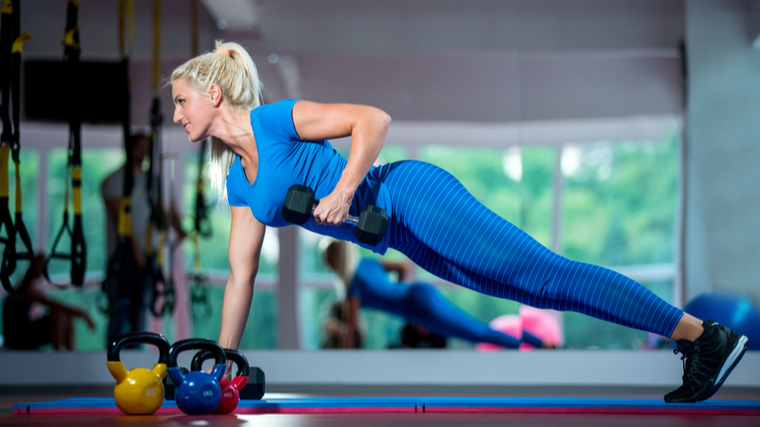
[Read More: The Best Upper Body Exercises and Workouts]
Olympic lifters may also find greater scapular stability and strength, which could help shoulder health if done properly. This is often the main concern for athletes who support weight overhead.
Casual Gymgoers
You don’t need to be a competitive strength athlete to want to develop elite-level back and core strength. Average gymgoers can access the renegade row relatively easily. If you’re not ready to add weight to the movement, you can simply practice a dynamic plank variation where you focus on keeping your body still as you row the air with your hands. You can even start on your knees if need be. This helps make the renegade row accessible to lifters who are building up the strength to support their own bodyweight.
Lift Like a Renegade
You don’t need a bench or a ridiculously heavy dumbbell to get in an effective rowing workout. If you’ve got a light hex dumbbell at home and need to work your back, renegade rows will come in handy. All you need is a solid plank position and enough discipline to keep your wrists in neutral. Control the weight through all your reps and you’re in for some serious back gains.
FAQs
You’re not the only one asking your most burning questions about renegade rows. Here are the most common questions about this strength-builder (and, of course, our answers).
Can you do renegade rows with kettlebells?
Yes. However, you need to be careful not to allow the kettlebells to tip over, which can result in wrist injuries or face planting onto the floor. Ideally, you would perform these with dumbbells. If you do not have dumbbells, perform a bent-over kettlebell row and superset that movement with a standard plank.
What is a renegade row push-up?
The renegade row push-up is a renegade row with a push-up added to it. Perform a row on both sides and then do a push-up. Those three movements constitute a single rep.
Are renegade rows better than regular rows?
Renegade rows are great for building more complete full-body stability, but regular rows allow you to lift more weight. If you’re looking to build maximum back muscle and strength, you might choose to opt for barbell rows or single-arm rows as your primary form of rowing. Still, supplementing these moves with renegade rows can help maintain a training emphasis on stability, which is essential for overall back strength.
Featured Image: BarBend
